AMD Radeon HD 7870 GHz Edition & Radeon HD 7850 Review: Rounding Out Southern Islands
by Ryan Smith on March 5, 2012 12:01 AM ESTPower, Temperature, & Noise
As always, we wrap up our look at a new video card with a look at the physical performance attributes: power consumption, temperatures, and noise. Thanks to TSMC’s 28nm process AMD has been able to offer 6900 series performance on a much smaller chip, but what has that done to power consumption and all of its related properties? Let’s find out.
Please note that we’re including our 7870-based 7850 in these charts, even though none of AMD’s partners will be shipping a card in this exact configuration. Power consumption should be nearly identical to shipping cards, but temperatures and noise readings are going to be significantly different since most of those cards will be using open air coolers.
| Radeon HD 7800 Series Voltages | ||||
| Ref 7870 Load | Ref 7850 Load | Ref 7870 Idle | ||
| 1.219v | 1.213v | 0.85v | ||
When getting a voltage reading on our 7800 cards through GPU-Z, it was interesting to note that the load voltage was almost identical between the two cards: 1.219v versus 1.213v. While we believe GPU-Z is giving us the right readings, we’re not sure whether the 7850 voltages are the same we’ll be seeing on shipping cards because of the PCB differences.

Idle power consumption looks quite good, as you’d expect from GCN. Idle power consumption is virtually identical to the 7900 series at the wall, and only the 7700 series can beat 112W. This further goes to show just how much progress has been made with idle power consumption – the Cayman based 6900 series had good idle power consumption for its time, and yet the 7800 series beats it by 5W+ at the wall.
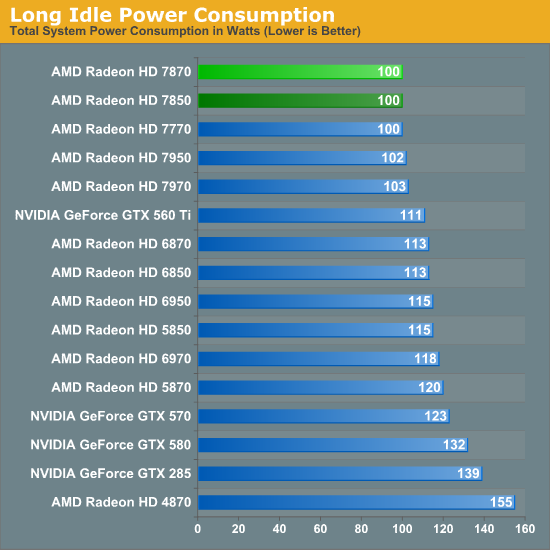
Long idle power consumption is virtually identical with the rest of the Southern Islands cards thanks to AMD’s ZeroCore Power technology. The next closest card is the GTX 560 Ti, and that’s at nearly 10W higher.
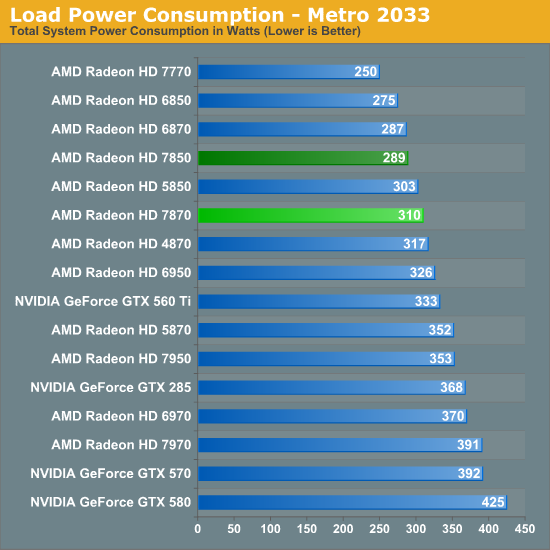
Moving on to load power testing, we have Metro 2033. Load power consumption here is about where you’d expect it to be, with the 7800 setups drawing more at the wall than the 6800 setups, but less than the 7900 and 6900 series. This is largely a consequence of performance, as the higher rendering performance of the 7800 series versus the 6800 series drives up CPU power consumption in order to generate more frames.
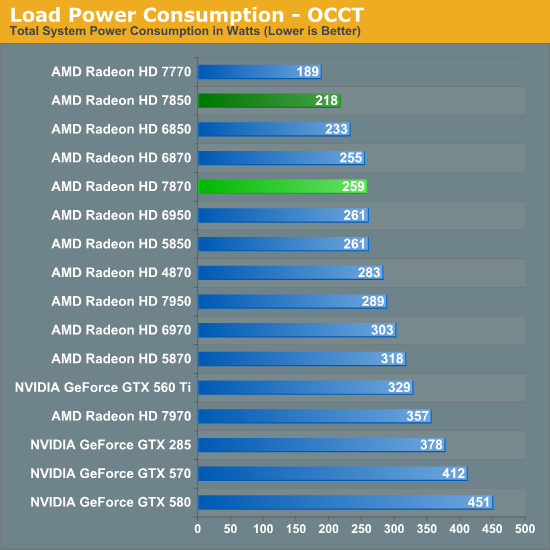
OCCT on the other hand gives us a more purified look at power consumption, and as you’d expect for 28nm it looks good. The 7870 ends up drawing only a few more watts at the wall compared to the 6870, showcasing the fact that the 7800 series is a drop-in replacement for the 6800 series from a power consumption perspective. The 7850 looks even better, capping out at 15W below the 6850, most likely as a result of PowerTune keeping the card firmly at 150W. Though it’s interesting to note that the measurements at the wall don’t perfectly align with the differences in PowerTune limits, with the 7850 drawing 30W more than the 7770 at the wall compared to a 50W PT difference, while the 7950 draws 30W more at the wall over the 7870 even though there’s only supposed to be a 10W PT difference.
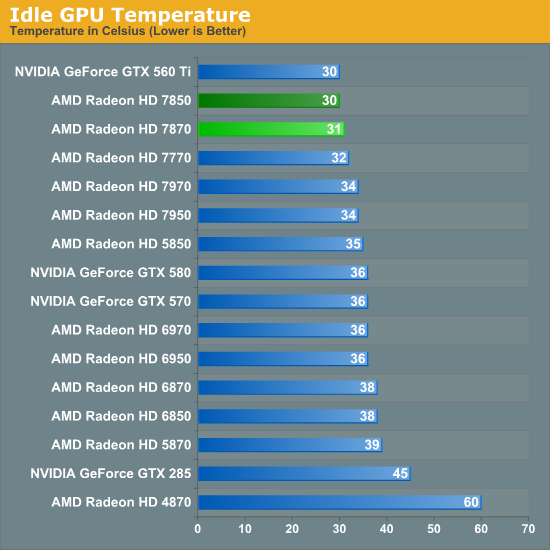
AMD’s latest generation blowers do quite well with idle temperatures and we can see it here. At 30C for the 7850 it’s every bit as cool as the GTX 560 Ti, while the entire 7800 series is around 5-8C cooler than the 6900.
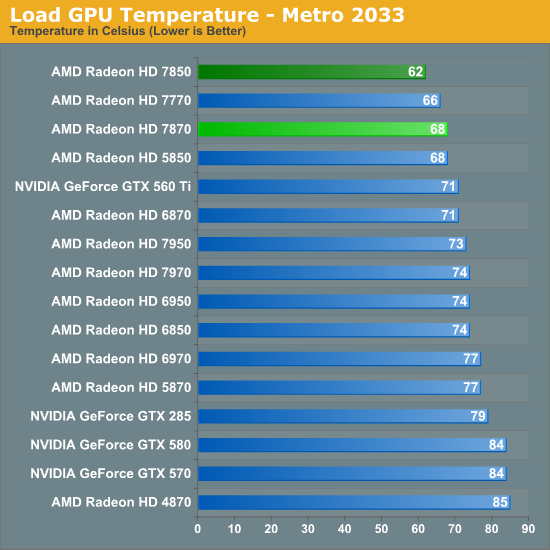
Under load, Metro temperatures are also quite good. At 62C the 7850 is the coolest card in this performance class, but keep in mind that it’s basically using an oversized cooler; retail cards will be open air coolers with much different characteristics. Otherwise at 68C the 7870 is still among the coolest cards, coming ahead of even the historically cool GTX 560 Ti, never mind the much hotter 6900 series.

Load temperatures climb under OCCT, but again the 7800 series is among the coolest temperatures we see. Here we see the 7870 peak at 73C, whereas its last generation counterpart would be at 80C and the GTX 570 at a toasty 87C.
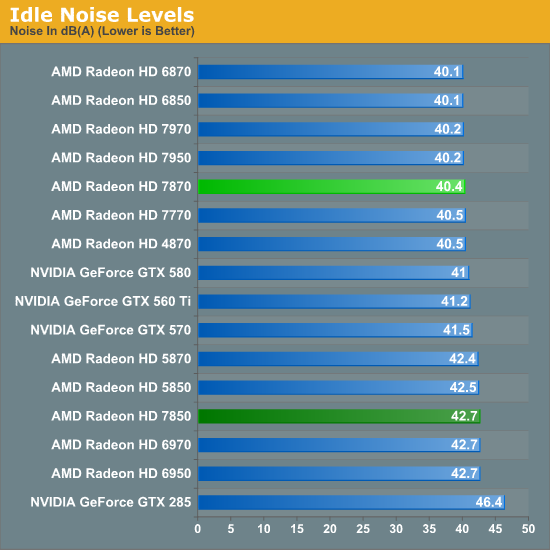
Moving on to noise testing, there are no major surprises at idle, with the 7870 hugging 40db. For whatever reason the 7850’s minimum fan state is roughly 200RPM higher than the 7870’s, but since no one will be using this cooler it’s not a significant result.
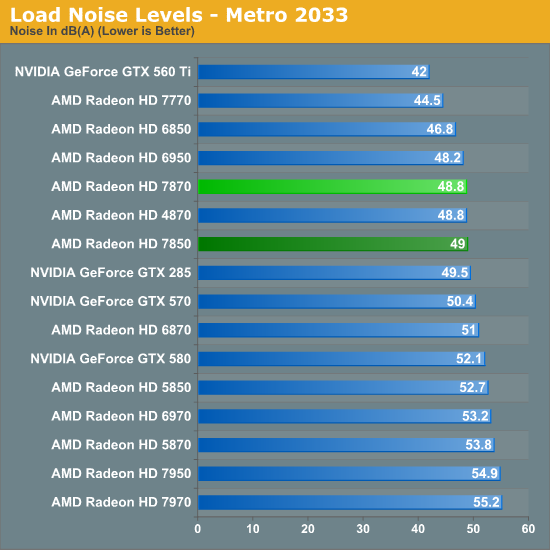
Consistent with AMD’s other 7000 series cards, we’re once again seeing the consequences of AMD’s aggressive cooling policies coupled with the use of a blower. At 48.8dB the 7870 is still quieter than the blower-based 6870, but it’s significantly louder than the open air cooled GTX 560 Ti, even though the latter consumes far more power and generates far more heat. This doesn’t make the use of a blower the wrong choice, but combined with aggressive cooling policies it does hurt AMD. The GTX 570, in spite of using much more power than the 7870, is only less than 2dB louder even though it too uses a blower.

Last, but not least we have our OCCT noise results. Unlike Metro the 7800 series does better on a relative basis here, but this is mostly because NVIDIA doesn’t have a power throttling system quite like PowerTune. At 51.9dB the 7870 is not the quietest card, but it still manages to beat the 6970 and the PowerTune-less 6870.
All things considered there are no great surprises here on a relative basis, as the 7800 series performs like we’d expect for a blower based sub-200W video card. Due to TSMC's 28nm process AMD greatly improves on their performance/power and performance/noise ratios with the 7800 series compared to the 6800 and 6900 series, while for their power class the 7800 series is slightly ahead of the pack on both power consumption and noise.
With that said, keep in mind that since most of AMD’s partners will be using open air coolers these results won’t be applicable to most retail cards. So for the temp/noise characteristics of retail cards you’ll want to look at individual card reviews when those start appearing later this month. This is particularly true for the 7950, where all of the retail cards will be using a different design than our sample.










173 Comments
View All Comments
Kaboose - Monday, March 5, 2012 - link
7870, beats GTX 570 and is about even with the GTX 580, uses 150watts less power at load, is quieter, is cooler, and has idle power draw > 23watts less. How is this a disappointment? The only disappointment i see is the price which is the result of no competition from Nvidia.Kiste - Monday, March 5, 2012 - link
A new generation of GPUs used to give us a whole hell of a lot more performance at any given price point. The current AMD stuff does not and that is a disappointment.Case in point: you even have to talk these things up by basically saying "oh, well, at least they draw less power".
Kaboose - Monday, March 5, 2012 - link
dropping power consumption by over 50% is something of a gimmick? Dropping load temps by 14c compared to the GTX 570 is not significant? 14c is a fairly large degree of deference, this gives higher room for overclocking as well as a cooler system overall. When Nvidia releases Kepler and we have both companies with 28nm then we can (hopefully) see some competition in price. In my opinion the 7870 at $325 would be a great card right now. Once Kepler is out $285-300 I think would be nice. I agree it is over priced right now however.If Nvidia releases Kepler and gives us a LOT more performance over last generation then I will concede that the 7xxx series is a failure. However from the way AMD is behaving it doesn't appear Kepler is going to do much in terms of raw performance either.
Kiste - Monday, March 5, 2012 - link
While reducing power consumption might not be a gimmick, it is the result of the new process node and thus in itself not particularly impressive, especially when you more or less keep the performance the same as with the previous generation.I'm still not impressed, sorry. Price/performance plain and simply sucks ass with these cards, barely beating the stuff that's on the market right now in that regard.
And even with the high-end SI cards there's barely much of a performance boost compared to what's already been on the market for months.
Sure, less power draw is nice. I won't complain about it but if a brand new generation of GPUs comes out and I am not even one little bit compelled to upgrade from my aging, heavily overclocked GTX570, then something is cleary wrong here.
Exodite - Monday, March 5, 2012 - link
We'll just have to wait and see what Nvidia provides when they finally decide to put competition on the market, won't we?I'd happily agree to finding the 7900-series not as high-performing as I'd like, and the 7700-series too expensive.
From the reviews I've read so far the 7800-series, the 7850 especially, is pretty much the perfect card ATM.
Low power, low noise, cool, 2GB VRAM and runs between a 560 Ti and 570 in performance.
It's definitely the card I'd recommend to anyone at this point, especially given the fact that we'll see better coolers than AMDs atrocities once we get release versions.
Iketh - Monday, March 5, 2012 - link
You must live in a cold climate. You're happy with a heavily overclocked 570?? I live in FL, and that card increases my power bill $30-$70 each month over my 6870 during 3 of the 4 seasons, and I'm talking from experience. Do you have any idea how hard an A/C has to work in a small 2 bedroom house to counter the blast of heat from an overclocked gaming rig??If you live in a hot climate, test it for yourself.
You don't compare just the power draw of the cards themselves....
Kiste - Monday, March 5, 2012 - link
I'm not quite sure if you're actually expecting a serious answer to that kind of hyperbolic drivel.Jamahl - Monday, March 5, 2012 - link
You really don't get it do you? These cards REALLY DO heat up rooms. Where do you think the heat goes? Ever heard of the law of conservation of energy?londiste - Monday, March 5, 2012 - link
oh damn, i need to get two of those, maybe they'll reduce my heating bill at winter :)Kiste - Monday, March 5, 2012 - link
Spelling "really do" in capital letter doesn't make it any more less ridiculous a statement.My whole PC (GPU, OCed CPU, 4 HDDS) draws slightly more than 300W under typical gaming loads. You can't "heat up a room" with that, much less with just the GPU.